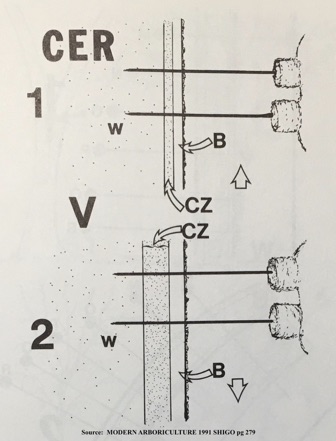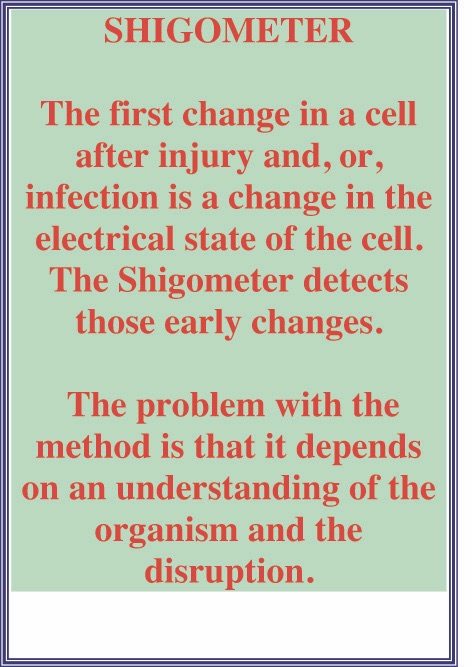SHIGOMETRY Cambium Electrical Resistance (CER)
First
The major
problem that has followed the meter since its beginning in 1970 has been the
lack of understanding of trees by the operators.
Keyword Definitions of Terms (Keyword
definitions give the most important words that define a term. Complete
sentences are not necessary.)
Capacity - What you have as a
result of your genetic code; a potential source for some future action or
product.
Ability - What you are doing
with what you have; a dynamic or kinetic process.
System - A highly ordered
connection of parts and processes that have a predetermined end point -
product, service.
Stress - A condition where a
system, or its parts, begins to operate near the limits for what it was
designed.
Strain - Disorder and disruption
of a system due to operation beyond the limits of stress.
Vigor - The capacity to resist
strain; a genetic factor, a potential force against any threats to survival.
Vitality - The ability to grow
under the conditions present; dynamic action.
Health - The ability to resist
strain.
Disease - A process that
decreases the order and energy of a living system to the point of strain.
Survival - The ability to remain
alive or functional under conditions that have the potential to cause
strain.
Generating system - New parts
and processes form in new spatial positions; plants.
Regenerating system - New parts
and processes form in old, or preoccupy, spatial positions; animals.
Wood - A highly ordered
connection of living, dying and dead cells that have walls of cellulose,
hemicellulose and lignin.
Symplast - The highly ordered
connection of living axial and radial parenchyma in wood and bark.
Apoplast - The highly ordered
connection of dead cells and cell parts that make up the framework that
holds the symplast.
Quality - The characteristics
that define a product, service or performance; quality can be low or high
Source: MODERN ARBORICULTURE 1991 SHIGO pg 279
243.
TREE VITALITY AND THE
CAMBIAL ZONE: CAMBIAL ELECTRICAL RESISTANCE
 The
thicker the cambial zone [CZ] the more vital [V] the tree. A thin cambial
zone [1] will have lower moisture and fewer cations than a thicker zone
[2]. When the double needle electrodes of the Shigometer are pushed through
the bark [B] and slightly into the wood [W] the pulsed electric current from
the meter passes through one needle, through the tree tissues, and back
through the other needle to the ohmmeter in the Shigometer where resistance
in kilohmís is measured.
The
thicker the cambial zone [CZ] the more vital [V] the tree. A thin cambial
zone [1] will have lower moisture and fewer cations than a thicker zone
[2]. When the double needle electrodes of the Shigometer are pushed through
the bark [B] and slightly into the wood [W] the pulsed electric current from
the meter passes through one needle, through the tree tissues, and back
through the other needle to the ohmmeter in the Shigometer where resistance
in kilohmís is measured.
Because the cambial zone is so moist and because it contains high amounts of
cations, most of the current flows through this zone. The higher the
electrical resistance, the less vital [V] the tree. You can develop CER
(cambial electrical resistance) records for your major trees in a very short
time. Select 20 trees of a species at random in any area. Take two
readings per tree; 40 readings. Divide the sum of all readings by 40. Now
you have your CER mean for that species. To work with many species. first
establish their means. Then use each mean as the denominator for each new
reading. For example with four different species: 5/5,6/6,7/7.8/8 etc. all
equal 1; and 10/5. 12/6, 14/7, 16/8. all equal 2. You then record each new
reading as a ratio of its mean. All trees with a 1 will indicate they are
the same as the mean. All trees with a fraction below 1 will be better than
the mean; and all trees with numbers higher than 1 will be worse than the
mean. All of this information can be easily stored in a computer for
comparison later.
Source: MODERN ARBORICULTURE 1991 SHIGO pg 279


Trees, like all organisms, die in three basic ways: depletion, dysfunction
and disruption.
See
"Demons Of D"
Forest Tree, City Tree
Trees
became tall, massive and long-living plants as they grew in groups. Trees
not only connect with other trees by way of root grafts but also by way of
the fungi that are associated with non-woody roots; the organs are called
mycorrhizae. Trees also connected with many other organisms, very large to
very small, in ways that benefited the trees and their associates.
Synergistic associations are important parts of the tree system.
A forest
is a system where trees and many associates are connected in ways that
ensure survival of all members.
It is
important to remember that the genetic codes for survival, or vigor, came
from trees growing in forests.
When the
forest-coded tree is brought into the city, the factors that affect vitality
become extremely important. The architecture of most city trees as they grow
as individuals is different from most of their relatives in the forest where
trees grow in groups. Forest trees have group protection and group defense.
The individual tree has neither.
Myth 69.
A
SHIGOMETER WILL TELL YOU HOW MUCH DECAY IS IN A TREE AND THE VITALITY OF THE
TREE. (MYTH)
The Shigometer gives resistance in K ohms. The operator must interpret
the numbers and their meanings. The meter is a tool. And, like any tool,
it is only as good as the user. The meter has been grossly misunderstood
and misused by many people who expected the meter to give them an answer.
The meter sends a pulsed electric current and with a variety of probes or
electrodes, the resistance of the current is measured in kilohms or
thousands of ohms. Once the pattern of measurements for any substrate and
its alterations are determined, the meter can rapidly help the operator to
understand the condition of other similar substrates. The major problem
that has followed the meter since its beginning in 1970 has been the lack of
understanding of trees by the operators. (See MODERN ARBORICULTURE pages
367-376)

Many
references on the SHIGOMETER can be found listed in rear MODERN
ARBORICULTURE. Remember a common issue is that people often quote sitings
and the info the claim is in the document does not exist. Not to mention
most research on diseases are done in a lab on 1 year old saplings.
Shigometry
Dictionary
MAIN
PAGE
Text & Graphics Copyright © 2019 Keslick & Son Modern Arboriculture
Please report web site problems, comments and words of interest,
not found.
Contact
 The
thicker the cambial zone [CZ] the more vital [V] the tree. A thin cambial
zone [1] will have lower moisture and fewer cations than a thicker zone
[2]. When the double needle electrodes of the Shigometer are pushed through
the bark [B] and slightly into the wood [W] the pulsed electric current from
the meter passes through one needle, through the tree tissues, and back
through the other needle to the ohmmeter in the Shigometer where resistance
in kilohmís is measured.
The
thicker the cambial zone [CZ] the more vital [V] the tree. A thin cambial
zone [1] will have lower moisture and fewer cations than a thicker zone
[2]. When the double needle electrodes of the Shigometer are pushed through
the bark [B] and slightly into the wood [W] the pulsed electric current from
the meter passes through one needle, through the tree tissues, and back
through the other needle to the ohmmeter in the Shigometer where resistance
in kilohmís is measured. 

